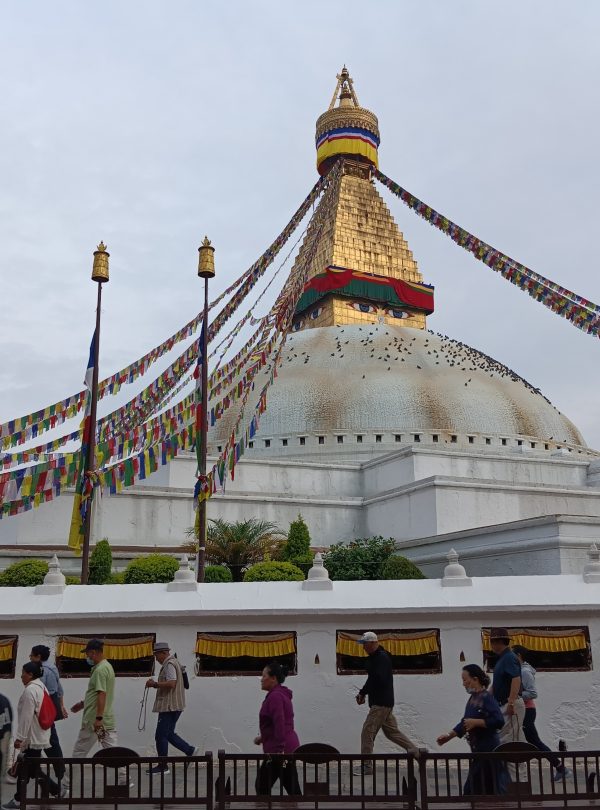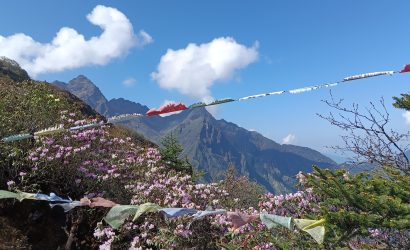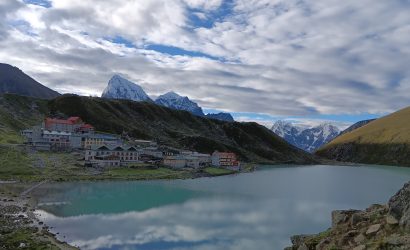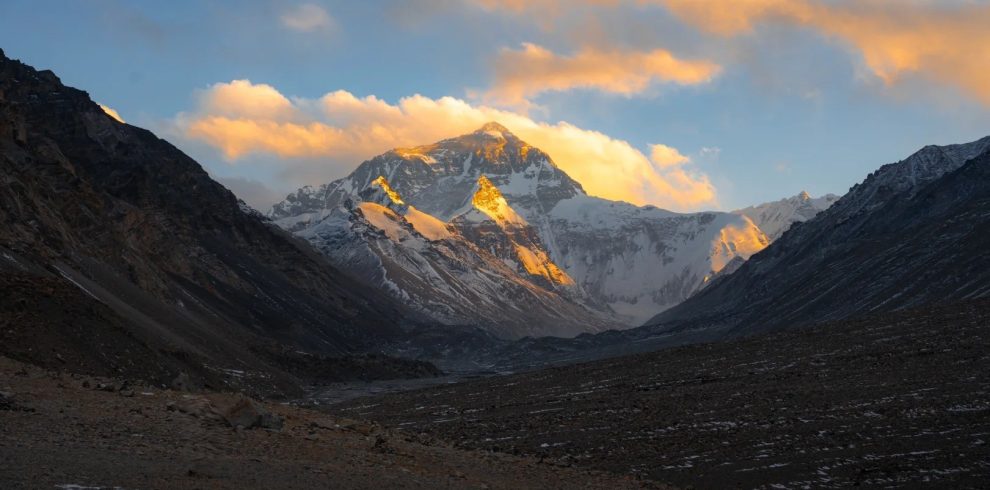The Mani Rimdu Festival Trek is an Everest region trek in Nepal that combines the scenic journey to Tengboche Monastery with witnessing the Mani Rimdu festival, a sacred Sherpa celebration featuring masked dances and rituals symbolizing the triumph of good over evil. Held annually in November, the festival culminates in three days of chanting, prayers, a sacred sand mandala, and blessing ceremonies by monks. Trekkers fly to Lukla, hike through the Khumbu region to Tengboche, experience the festivities, and then return to Lukla to fly back to Kathmandu.
Overview
Mani Rimdu festival is traditionally celebrated by the Sherpa communities in Nepal, the Himalayan Regions of Tibet, Bhutan, and India. It is an important religious event for the Sherpa people, and it is typically organized and performed by local monasteries or lamas. The festival is also becoming increasingly popular among other ethnic groups and tourists, and as a result, it is being celebrated by a wider range of people from different parts of the world.
Trip Highlights
- The Mani Rimdu Festival Trek offers the opportunity to combine the cultural experience with the adventure of trekking in the Everest region.
- The trek offers a comprehensive journey through the Everest region, allowing trekkers to experience the rich cultural heritage of the Sherpa people.
- Trekkers have the opportunity to immerse themselves in the Sherpa culture, gaining insights into their traditions, lifestyle, and beliefs.
- Visit traditional Sherpa villages to learn about their unique culture and traditions.
- Follow an adventurous trail to Tengboche village through the heart of the Himalayas.
- Opportunity to witness the colourful Chham dance, as well as the other rituals and ceremonies that take place over the three days of the festival.
- Panoramic views of Mount Everest and other Himalayan peaks, along with diverse landscapes.
- Trek through beautiful rhododendron forests, crossing rushing rivers and fine villages.
- Celebrate a Buddhist festival in exotic setting with Might Mount Everest.
- Hike through Sagarmatha National Park, a UNESCO Heritage Site.
Itinerary
You will arrive at the Tribhuvan International Airport in Kathmandu. Everest Alpine Trekking senior representative will greet you once you clear your immigration process outside the terminal building. He or she will then escort you safely to your destination hotel. Once there, you will have plenty of free time to rest and relax. Later, we meet for a welcome dinner with the whole group. You will then spend the night in Kathmandu.
Today you have a full day of guided sightseeing around the Buddhist and Hindu sights in Kathmandu, probably to Kathmandu Durbar Square and Swyambhunath, a combination of Hindu and Buddhist temples known as the Monkey Temple because there are many monkeys living around the temple. Pashupatinath is a sacred Hindu temple situated on the bank of the Bagmati River. Then drive to the Bouddhanath stupa, one of the biggest and oldest Buddhist stupas in the world.
Later in the afternoon, there will be a pre-trip meeting with your trekking guide in the hotel. Our office representative will brief you regarding our trek as well as provide you with the opportunity to ask any questions about the upcoming trip with your guide. And spend the night in Kathmandu.
After a good night's rest and wholesome breakfast, we drive to the domestic airport for a scenic flight to Lukla. At Lukla, you will be meeting the local porters with whom you will start trekking adventures all along the Dudh Koshi River. Following the trail, we reach Cheplung (2,700 m) and then a place called Ghat (2,530 m). From here, an hour’s walk reaches the small settlement at Phakding. Overnight in a guest house at Phakding.
After an early morning breakfast, we begin our walk through a pine forest and move all along the trail north that takes us to the Benkar valley. We then cross the Dudh Koshi River and pass through Chumoa and Monjo villages, which serve as the entrance to the Everest National Park. We then cross a suspension bridge before Jorsale village and walk alongside the Dudh Koshi River. Beyond this, a steep climb awaits us before we reach Namche Bazaar. This is by far one of the largest Sherpa-inhabited towns in the Everest region. Overnight in Namche Bazaar.
Today is meant for laid-back exploration and rest at Namche Bazaar. This is one of the most important towns in the Everest or Khumbu regions. This town is a mini-world in itself. It has government offices, ATMs, internet cafes, shops, restaurants, and a vibrant market.
You have the choice of spending your time here or hiking up to the Sagarmatha National Park to get the first glimpse of the sunrise. The panoramic views of the Himalayas, including Mt. Everest, Lhotse, Nuptse, Ama Dablam, Thamserku, Kongde, and so on, are rewarding.
If you are looking for more than a hike, Khumjung Village is an ideal option to get a closer look at Sherpa culture and tradition than Namche. We will also visit the Hillary School and a monastery that comprises a skull known to be that of a yeti and an abominable snowman. Overnight in Namche Bazaar.
From Namche, we start trekking and reach Phunki, which is an easy and pleasant walk. We then make an ideal ascent for reaching as far as Tengboche village. This village is known for its world-class Tengboche Monastery, the largest monastery in the Everest region. The monastery is lapped against the backdrop of Mt. Ama Dablam and offers the best view of the Himalayas, including Mt. Everest, Nuptse, Lhotse, and Thamserku. Overnight in Tengboche.
Today we begin our day with a lovely morning at Tengboche. After having our breakfast and knowing the designated time for the blessing, we go towards the Tengboche monastery and attend some meditation, and soon after that, we receive the blessing from the monk and spend our day with the locals.
Today is our second day of the festival, and today we celebrate with the locals. We can observe the locals and the monks doing various rituals, people wearing various costumes and masks waiting for the locals and the monks to do the rituals and music, and people dancing all along while wearing the masks.
Today is the last day at the festival, and today is the last day at Tengboche, where we witness the jinsak. offering to Agni (the god of fire) and to the gods of the mandala to allay all harm in the world. After the destruction of the sand mandala, sand is given as an offering to the serpent gods.
The day begins with an ideal descent and also a long walk through the forested route of birch, conifer, and rhododendron trees. As we move on, we will be greeted by the best views of Mt. Everest, Lhotse, and Ama Dablam.
We then walk downhill to Debuche and cross the Imja Khola River to reach as far as Pangboche. Taking the upper Pangboche trail and observing the magnificent Himalayan vistas, we reach Pangboche Monastery.
Taking the route that follows the Imja Valley and Lobuche River, we make a climb toward Dingboche. Dingboche is a small yet scenic village decorated with beautiful barley, potato, and buckwheat fields. Overnight in Dingboche.
The eleventh day of your 14/18 days at Everest Base Camp is meant for acclimatization and rest. As we have time on our hands, we pay a visit to the Dingboche monastery and hike up to Nangkhartshang Peak. Besides that, the panoramic views of Mt. Everest, Amadablam, Lhotse, Tawache, Nuptse, Kwangde, etc. at a striking distance make it eventful. Stay overnight in the guest house.
After a quick breakfast, we set out on a trail with excellent views written all over it, especially the likes of Taboche and Cholatse, which made it refreshing. We pass through the yak meadows and then over the wooden bridge to Duglha. Next, we make a steep climb for almost an hour up towards the graveled terminal moraine of the Khumbu Glacier. A large group of stones dedicated to the memory of lost climbers and Sherpas during their Everest expedition can be found here. From here, the awe-inspiring views of Khumbutse, Lingtren, and Pumori are more than rewarding. We then walked along the valley and climbed for an hour to reach Lobuche. Overnight in Lobuche.
Be prepared for a long day's walk as we follow the windblown, rocky path along the arid Khumbu moraine to the last settlement of Gorakshep. An ideal stopover for getting fueled up for reaching the world’s highest base camp is understandable. We follow the trail that leads us on to the Khumbu Glacier, infamously known for its treacherous icefall, which is scary yet acceptable. This is the most challenging part of an Everest ascent. From here, we trek back to Gorakshep. Overnight in Gorakshep.
Be prepared for a long day's walk as we follow the windblown, rocky path along the arid Khumbu moraine to the last settlement of Gorakshep. An ideal stopover for getting fueled up for reaching the world’s highest base camp is understandable. We follow the trail that leads us on to the Khumbu Glacier, infamously known for its treacherous icefall, which is scary yet acceptable. This is the most challenging part of an Everest ascent. From here, we trek back to Gorakshep. Overnight in Gorakshep.
There is something special on the trekking menu today as we get up early to brace ourselves for a pre-sunrise glimpse without the cloud cover. We climb for 2-3 hours uphill with the goal of reaching Kala Patthar (5,545 m). This is an excellent vantage point to enjoy the sunrise on the top of the world’s highest peak, Mt. Everest. Taking on a fairly steep trail at a gradual pace, we get a splendid sighting of the tremendous views of the Lingtren, Khumbutse, Mt. Nuptse, Mt. Lhotse, Ama Dablam, Changtse mountains, and many more. Here we spend some time admiring the sunrise views and kissing the adjacent mountain peak, which is memorable. Later on, we retrace our steps back to Gorakshep, take our breakfast, and then descend down to Pheriche. Overnight in Pheriche.
Today we leave Pheriche for Namche Bazar. Following a descending trail that involves various ups and downs with ideal rhododendron and juniper trees along the way, we then cross a bridge over the Dudh Koshi River. We climb rapidly down a forested trail where we can discover mountain goats, pheasants, and other wild animals and birds. The same trail takes us to Sansa, from where we get a great view of the Ama Dablam, Thamserku, and Nuptse mountains. An unwinding zigzag trail through the forest leads us to the Namche Bazaar. Overnight in Namche Bazaar.
This is the last day of your 14 Day trek from Everest Base Camp up into the mountains. After breakfast, we descend, following a trail all along the Dudh Koshi River. We then crossed several suspension bridges and passed through several monasteries and villages before arriving in Lukla. After reaching Lukla, we take a much-needed rest and indulge in a celebration with our porters for our achievement and success. Overnight in Lukla.
An early morning rise is on the cards as we will be boarding the Lukla flight back to Kathmandu. Once in Kathmandu, we will get back to our hotel room. Farewell dinner and overnight in Kathmandu.
This is the final day of your Nepal Mani Rimdu Festival Trek, Everest Base Camp Trek. Everest Alpine Trekking’s representative will drive you back to Tribhuvan International Airport. You will then board your flight back home, carrying memories that will captivate your imagination for the rest of your life.
Cost Includes
- Airport transfers.
- Deluxe/Standard rooms in Kathmandu on twin/double sharing basis with breakfast and dinner.
- Guided sightseeing tour in Kathmandu .
- Accommodation during trek (or camping in case of need).
- All meals (Breakfast, Lunch, Dinner) during the trek.
- Authorized English speaking guide along with Porters(3:1) for the trek.
- Two-way Kathmandu-Lukla airfare with domestic airport departure tax.
- Equipment and clothing for porters including their insurance.
- All applicable government tax.
- All expenses for staffs–meal, accommodation, salary, equipment, insurance, transportation.
- All necessary paperwork and Everest Trekking Permit, Trekkers' Information Management System fees (TIMS).
- Medical kit (carried by your trek leader).
Cost Excludes
- Your Personal Travel Insurance.
- Nepal Entry Visa Fee.
- Lunch & Dinner in cities - allow $ 13 to 16 for per meal in Tourist restaurants.
- Beverages (drinks, mineral water,boiled water and beer).
- Tips for guide, porters and driver (customary).
- Any personal expenses not mentioned in above services.
- Additional night accommodation in Kathmandu because of early return from Trek.
FAQS
No, the booking deposit is non-refundable, but is definitely reusable for the next season of the same year. This means, if you are unable to do this trek for any reason, the booking deposit already paid to the company can be used to book another trip for the next season of the same year.
The frequency of the trip completely depends on the volume received by the company every year.Everest Alpine Trekking, however, has the expertise, manpower, experience, congenial relation with service providers and the dedication required to run trips on a daily basis and throughout the y
The cost of the Everest Mani Rimdu Festival Trek varies from $1485-$1800 depending upon the number of days you choose to trek. The longer the trek, more expensive it will become. Similarly, the price will differ with the accommodation choices also. Normally, Nature Lovers Treks and Tours offers a comprehensive package which is inclusive of all the cost and expenses for the entire journey from the moment you land in Nepal till the moment you fly back home. However, you could also choose to buy only service-based package from us when we will be providing you only the supporting field staffs plus trekking permits and you have to arrange the rest by yourselves.
For Everest Mani Rimdu Festival Trek, you will need to make two permits: Sagarmatha National Park Entrance fee (can be made in Nepal Tourism Board at Kathmandu or in Monjo) and Khumbu Pasang Lhamu Rural Municipality Entrance fee (obtained in Lukla).
You can easily charge your electronic devices during Everest Mani Rimdu Festival Trek but by paying small amount or fees for charging. Don’t forget to buy a plug adapter or socket fittings before you leave Kathmandu.
The Everest Mani Rimdu Festival Trek, we will provide you the teahouse accommodations. A teahouse is typically a mountain lodge which is a combination of a lodge or a guest house and a restaurant or a café with basic furniture and interiors suitable for the social hangout. Many teahouses even have some attached bathrooms and the central heating furnace. Most of the teahouses provide the European toilets these days while Asian style of toilets are available in every teahouses. Hot showers are available but on extra cost. The same goes with the hot drinking water since they use the gas or solar to boil the water. Sleeping blankets are usually provided but we recommend you to carry your own sleeping bags for the hygienic purpose (can be arranged on request). At the same time, it’s better to carry your own toiletries including the towels.
Everest Mani Rimdu Festival happens only between mid-October and mid-November, once in a year only. This year, this festival is going to be celebrated on October. Everest Mani Rimdu festival occurs in the best month of the year which is also the busy tourism season in Nepal since the skylines get really clear and wonderful during this time period.
The itinerary of our Everest Mani Rimdu Festival Trek is perfectly designed by Everest Alpine Trekking, Nature Lovers Everest Alpine Trekking and has separated enough time in the places to let the body acclimatize well in high altitudes. As long as you follow the guide, you should be fine. Altitude sickness in fact can affect anyone regardless of the age or the fitness level, so it is very important to walk slowly and gradually as you go higher. Learn more in details about Altitude Sickness to prepare yourselves for the upcoming Everest Mani Rimdu Festival Trek.
Full meals are included during the trek. Tea and coffee will also be provided during the entire trip. During the trek, you will have your breakfast and dinner in the same teahouse where you spend the night while the lunch will be served en route towards the next destination of the day. There are a varieties of choices to choose from; Nepalese, Tibetan, Indian, Continental.
The most common and the highly recommended food during the Everest Mani Rimdu Festival Trek is typical Nepali Dal Bhat {rice and lentil}; even better without meat, means Nepali Vegetarian Dal Bhat. You can also eat other food items such as seasonal vegetables, noodles and spaghetti, pastas, pizzas and French fries, soups, etc. depending upon the availability. For the beverage, you can either choose warm, hot or cold beverages; soft drinks, beer and hard drinks. For the breakfast, you can order cereals, breads, noodle soups, egg dishes.
Choosing the right gear and equipment is important as well for the successful trek to Everest region. Pack the right gears and equipment but remember, packing as light as possible is the best way to go when trekking to Everest Mani Rimdu Festival. You should read this What to take for travel to get all the details on what you need to pack or carry.
Everest Mani Rimdu Festival Trek route has good mobile network coverage these days, thanks to the Nepalese telecommunication companies called Ncell and NTC. You can buy one of these Sim cards from any local phone shops in Kathmandu and use the mobile data on trek.
WiFi is easily available on purchase in Everest Mani Rimdu Festival Trek route. There are some internet cafes along the route as well from where you can use WiFi to communicate with your loved ones which is comparatively cheaper than buying the WiFi packs. However, the signal varies from place to place and please don’t expect to receive the fast data coverage in the trek.
Travel insurance is a must when you trek to Everest Mani Rimdu Festival. Therefore before you come to Nepal, please make sure you have your insurance documents with you since our insurance companies cannot insure foreign nationals. Because of the reason that they cover all the expenses, if you face some unfortunate happenings and you have to be rescued or medically assisted during the trip or if your belongings are lost or stolen. We strongly advise you to take out an insurance which covers any medical risks up to 4000 meter as well as the medical evacuation from the mountains.














